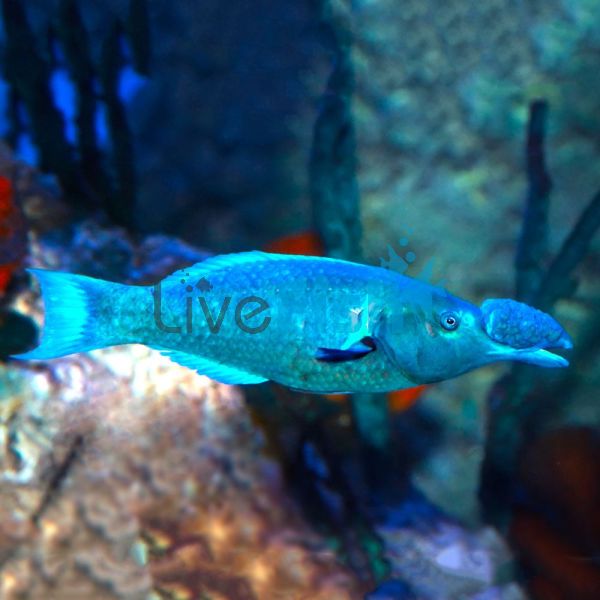Green Birdmouth Wrasse - Medium
The Green Birdmouth Wrasse isn't often available and so if you acquire one of these unique looking individuals, you'll be the envy of fellow aquarists.
Green Birdmouth Wrasse
Green Birdmouth Wrasse are named because of their beak-shaped snout. It is used to forage invertebrates, crustaceans, and small fish, in coral, sand, and rocks. Males and females vary in color, as do juveniles from adults. Females have a pale, yellow stomach, and green/blue upper body. They have yellow anal and tail fins, and a dark stripe over their eye. Males are a deep, dark blue color, with a bright blue trim on pectoral fins, and green dorsal and anal fins. Juveniles are paler with a dark line from the face to the body. Adults can grow to a maximum length of 12 inches (30 centimeters).
There is very little information regarding mating. They are hermaphroditic, with a female changing to male when required. Observations in a tank environment do show possible breeding patterns. The male and female will dart in and out of rock work with erect top fins. They meet at the top of the tank and, after touching, release gametes.
Green Birdmouth Wrasse are native to the Indian Ocean, from the East coast of Africa to the Andaman Sea. They inhabit coral-rich reefs and lagoons between depths of 1-30 meters.
Tank Recommendations for Green Birdmouth Wrasse
The aquarium should be at least 125 gallons (473 liters) and 6 feet in length.
Green Birdmouth Wrasse is not suitable for a reef environment. They should be housed in a Fish Only With Live Rock (FOWLR) tank. The best substrate is fine sand, at least 4 inches deep. A tank should have plenty of live rock or rockwork with crevice and caves. This provides feeding opportunities and places to hide.
These are active fish that need plenty of room for swimming. They are also capable of jumping out of the tank, so a secure lid is essential.
Suitable Tank Buddies
Green Birdmouth Wrasse is semi-aggressive. They are tolerant of most fish but see invertebrates and some small fish as prey. More docile fish may find this Wrasses' behavior intimidating and stressful.
Usually Compatible
Conspecifics as a male/female pair but introduce the female first. If a female is introduced without adding a male, then she will become male. Semi-aggressive fish such as Tangs, Anthias, and Angels are suitable. Aggressive fish can co-habit as long as they are over 3 inches long. Groupers, Lionfish, and large Dottybacks are ok.
Sometime Compatible
Peaceful fish such as Fairy Wrasse, Dartfish, and Gobies need monitoring. This species may be too active and intimidating for more peaceful fish. It may also consume smaller peaceful fish.
Rarely Compatible
Pipefish and Seahorse are unsuitable tank buddies. Crustaceans and Invertebrates are at risk as they are part of the Wrasse diet. Do not house it with Clams, Crabs, Oysters, Shrimp, Starfish, and Worms.
Feeding Your Green Birdmouth Wrasse
Green Birdmouth Wrasse are carnivores. They eat a wide range of meaty foods, such as crustacean flesh, marine fish, and invertebrates. A good diet should include Mysis Shrimp, vitamin-enriched Brine Shrimp, and Squid. They will also eat flake food and occasionally pellets. Wrasse should be fed several times per day.
| Scientific Name | Gomphosus caeruleus |
|---|---|
| Care Level | Easy |
| Common Names | Indian Bird Wrasse, Green Birdmouth Wrasse, Blue Bird Wrasse, Red Sea Bird Wrasse, Blue Clubnose Wrasse, Blue Green Bird Wrasse. |
| Diet | Carnivore |
| Fish Family | Labridae |
| Max. Length (cm) | 30 |
| Min. Tank Volume (l) | 473 |
| Origin | Indian Ocean, from the East coast of Africa to the Andaman Sea |
| Reef Safe | No |
| Sociability | Semi-aggressive |
| Venomous | No |
| Water Conditions | 23-27° C (74-82° F), dKH 8-12, pH 8.0-8.5, sg 1.020-1.026 |




